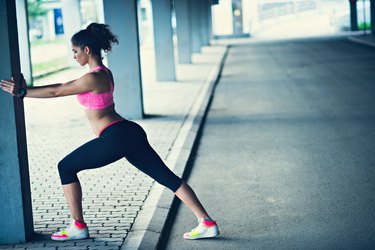
The first step to building stronger leg muscles is to establish your baseline fitness level, so you can work on improving it. When it comes to determining your leg strength, there are a number of exercises you can do to gauge your current level of leg strength. Try a combination of tests in order to get a comprehensive picture of your current muscular endurance level.
In addition to determining your leg strength, consider also testing your legs' flexibility and balancing ability. Once you have all this information, you can create a plan that improves all three measures of physical fitness.
Video of the Day
Video of the Day
One-Legged Squat
The single-legged squat serves double-duty — not only can you perform this maneuver to strengthen your legs, but to determine your current individual leg strength. It will also unmask hidden weaknesses in your knees, glutes, hip adductors and calves.
How-To: While standing, lift your left foot off the floor and hold your arms at shoulder-height in front of you for balance. Squat down as far as you can on your right leg while keeping the left leg off the floor. Repeat and then perform the squat on your left leg.
One-Rep-Max Back Squat
The back squat test measures the maximum amount of weight that you can squat one time. Prior to starting the test, complete a 5- to 10-minute warm up consisting of a light cardiovascular activity so your muscles are ready for the work the exercise requires.
How-To: To complete the test, start with 10 repetitions of back squat without using any weight and then rest for 60 minutes. Next, complete three to five repetitions using a weight that you would be unable to complete six repetitions with and then rest for 2 minutes. Add weight and do two to three repetitions, followed by a 3-minute rest. Add more weight and attempt to complete a single repetition. If you succeed, rest 3 minutes, then add weight and try again, continuing this method until you're unable to complete a single repetition.

Read More: How to Increase Leg Muscle Strength
Wall Sit
The wall sit measures your isometric leg strength, or the ability of your legs to hold a contraction over time.
How-To: Stand with your back against the wall and slide your feet out about 12 inches in front of you. Slide your back down the wall until your thighs become parallel with the floor. Hold this position for as long as possible. Do not place your hands on your knees.
A score of excellent goes to males who can last greater than 100 seconds and to females who can last greater than 60 seconds. Good scores go to males who last 75 to 100 seconds and females who last 45 to 60 seconds. Average scores go to males who last 50 to 75 seconds and females who last 35 to 45 seconds. Males who score 50 or below and females who score 35 or below are considered below average.